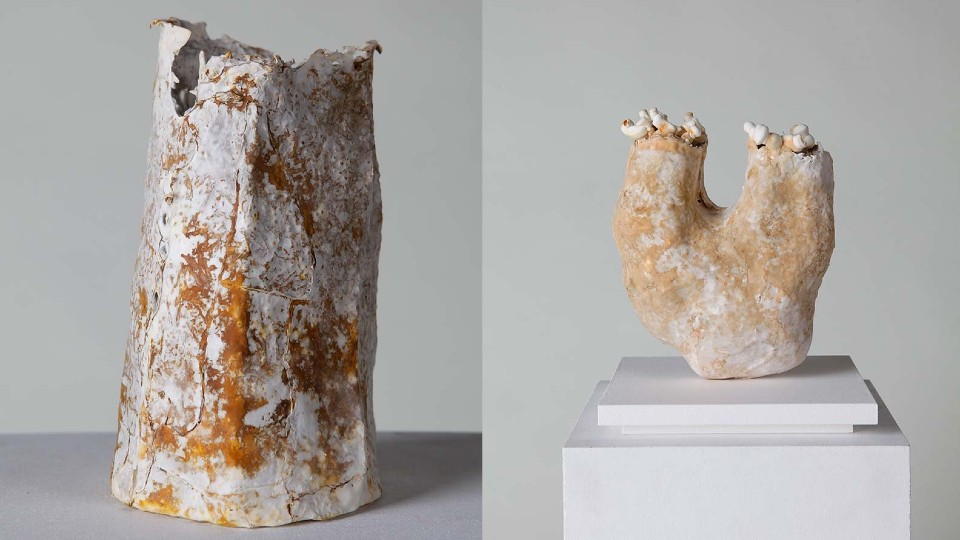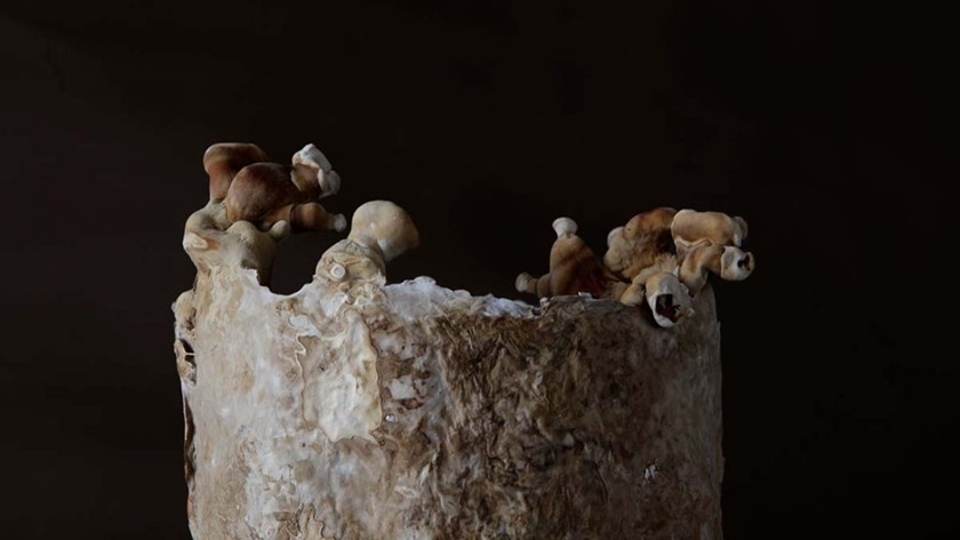Recent Textile Design graduate, Georgie Gerrard, has created a collection of sculptures using the mycelium of reishi, an ancient fungus nicknamed the ‘mushroom of immortality’ due to its purported health benefits.
Mycelium is the root-like structure of a fungus that consists of a network of threads, called hyphae. Fungal colonies of mycelium are often found on or in soil but can also thrive in other places, such as rotting tree trunks.
Inspired by her geologist grandfather, Georgie wanted to harness mycelium’s ability to bind to substrates to create solid materials to showcase its sculptural and functional potential and highlight the tie between people and place.
“Mycelium uses whatever substrate it is in as a nutritious medium to form a web-like structure. I found it poetic how mycelium connects and binds together with materials using its branches and wanted to explore this in my pieces”, Georgie explained.
“My project is conceptually based on my ties with family located in different corners of the country, and even on the other side of the world.
“I came across hundreds of my late grandfather’s film slides from geology field trips and family holidays, in which he relentlessly photographed geological features, rocks, fossils, etc. The love of his subject brought me to think about how family can tie you to a place.”
Based on where her family is located, Georgie grew mycelium in substrates from or representative of Devon, Dorset, Surrey, Leicestershire, Bolton, and Bolivia.
To create substrates, Georgia took clay taken from Bolton, Devon, Surrey, and Leicestershire, and gathered materials of cultural significance to each area.
For example, Georgie added beetroot pigment to the substrate representative of Bolivia as the Laguna Colorada in the Bolivian Altiplano is a deep red-pink colour due to the algae in it. She also included materials she associates with the country, including alpaca wool, sheep wool, and straw.
 Left: 'Surrey' mycelium sculpture grown from reishi millet grain spawn, eucalyptus paper, wheat bran, and yellow clay dug up from Cranleigh, in Surrey. Right: 'Dorset: Durdle Door' mycelium sculpture based on the geologically fascinating Durdle Door on the south coast of England, grown from reishi oat seed spawn with barley straw, eucalyptus paper, wheat bran, and clay.
Left: 'Surrey' mycelium sculpture grown from reishi millet grain spawn, eucalyptus paper, wheat bran, and yellow clay dug up from Cranleigh, in Surrey. Right: 'Dorset: Durdle Door' mycelium sculpture based on the geologically fascinating Durdle Door on the south coast of England, grown from reishi oat seed spawn with barley straw, eucalyptus paper, wheat bran, and clay.
To create the sculptures, Georgia first made moulds and subject the substrates to intense sterilisation in the campus STEM labs. She then pressed the mycelium and custom substrate into the moulds, and left them to grow in a greenhouse.
The mycelium and mushrooms were grown for around three weeks and then dried, leaving behind a lightweight, environmentally-friendly sculpture.
Georgie hopes her sculptures will prompt conversations about the unusual material. She said: “Mycelium is a 100% biodegradable material that boasts properties such as being antibacterial, fire-resistant, thermal, and acoustic insulating, and arguably most importantly, can digest waste materials and by-products, including plastics in some cases.
“Although my sculptures aren’t made to be functional, mycelium is a material with huge potential for these reasons.
“I think it not only can look aesthetically beautiful and intriguing but is an important material for people to learn about, understand its benefits and hopefully start implementing into future design.”
More information on Georgie’s collection, titled ‘6 Locations’, can be found on the dedicated Design, Creative Arts and Architecture Degree Show 2022 webpage.
